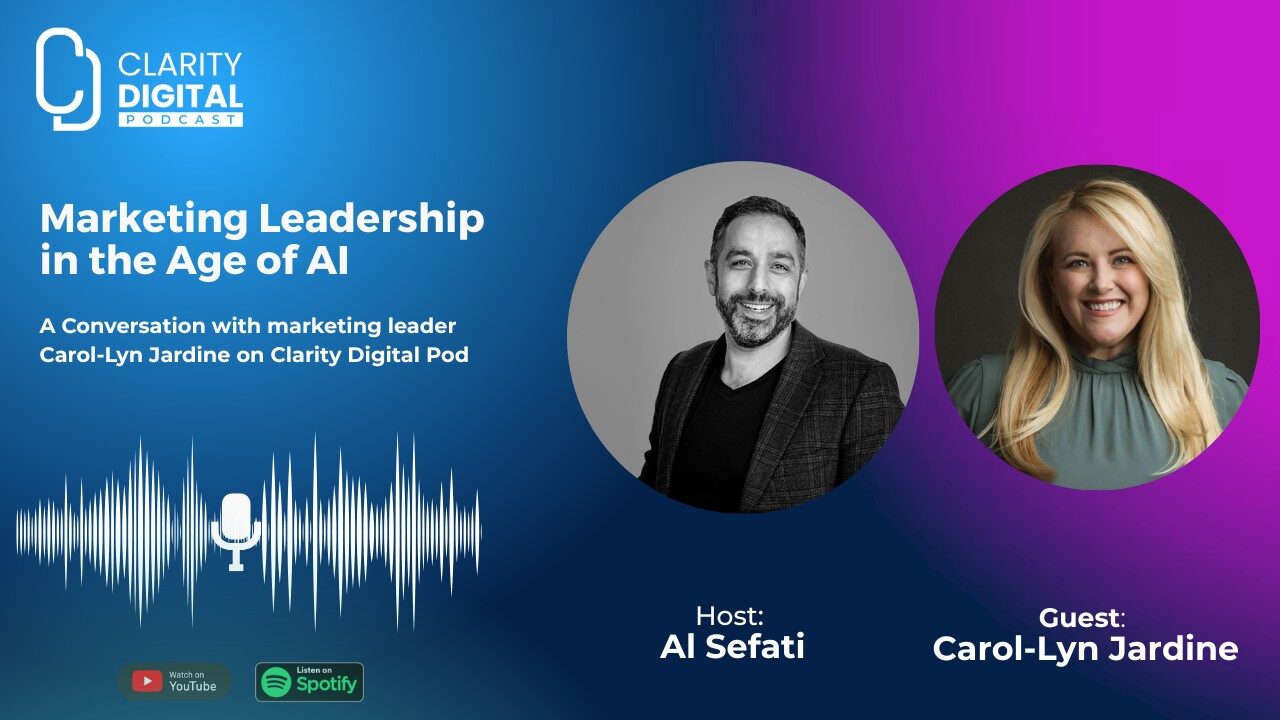In this episode of the Clarity Digital Pod, I sat down with Carol-Lyn Jardine to talk about leading marketing teams through massive change. We explored how AI is reshaping the buyer journey, what economic uncertainty means for go-to-market strategies, and how marketing leaders can balance technology, strategy, and team culture in this new era.
Navigating Marketing Leadership During Disruption
Carol-Lyn Jardine joined me to discuss what it’s like to lead marketing teams at a time when everything is shifting—buyer behavior, economic pressure, and the rapid adoption of AI.
“I don’t know if there’s a better word than crazy right now,” Carol-Lyn said early in our conversation. “I haven’t experienced a time in my career with this much disruption and this much pressure all at once.”
Economic Uncertainty and Its Impact on Marketing
We talked about how even companies performing well are holding back because of unknowns in the economy.
“Marketing is always the first thing to get scaled back,” I told her. “We had a client pause campaigns saying, ‘We’re focusing on product and retention until things feel more certain.’”
Carol-Lyn agreed and highlighted the dual challenge marketing leaders face: staying agile while planning long-term strategy in an unpredictable environment.
How AI Is Changing the Buyer Journey
One of the biggest topics we covered was the way AI and digital acceleration are reshaping how customers buy.
From Field Events to Digital-First Journeys
Carol-Lyn traced the evolution from traditional enterprise buying cycles to fully digital experiences.
“Before COVID, a complex B2B deal might start on the website, go through a couple of field events, webinars, and then sales interactions,” she explained. “COVID forced everything digital overnight and accelerated change that was already happening.”
Post-COVID, she said, buyers now stay anonymous much longer, making decisions through their networks and only engaging companies late in the process.
AI’s Role in the Next Shift
Layered on top of that is the AI revolution.
“AI is making some things better and some things worse,” Carol-Lyn said. “The sheer quantity of AI-generated outreach right now is overwhelming. It’s creating more noise, which means marketing teams have to be even more strategic about cutting through.”
I shared my own experience using conversational AI to plan strategy and noted, “I don’t type keywords anymore. I have conversations with AI tools to brainstorm ideas. That alone changes how we think about the buyer journey.”
Building AI-Enabled Marketing Teams
Carol-Lyn’s experience leading AI transformation inside a marketing organization brought a lot of practical insight to the conversation.
Policy vs. Experimentation
We discussed whether companies should have strict AI policies or allow teams to experiment.
“When it comes to product and IP, yes, you need strong policy,” Carol-Lyn said. “But in marketing, we need the handcuffs off right now to experiment and figure it out. Nobody actually knows the best way to implement AI on a marketing team yet. It’s too new and changing too fast.”
From Fear to Strategy Partner
She also shared how her team’s relationship with AI evolved.
“At first, most people were scared. They wondered if AI was going to take their job,” she said. “But once they realized the output was only as good as the human input, they started using AI as a thought partner instead of just a content generator.”
One of her favorite examples was a content strategist who used AI to rethink the entire content strategy instead of just speeding up writing tasks.
Moving from Tactical to Strategic Work
Both of us agreed that AI is shifting marketing roles away from pure execution toward strategy.
“We’re slowly moving from being tacticians to strategic partners,” I said. “That’s actually a good thing—it lets us focus on solving bigger problems for clients.”
Carol-Lyn echoed that sentiment:
“The value of AI right now isn’t replacing people—it’s giving them the capacity to clear tactical work off their plate and finally get to the strategic ideas that have been sitting on the back burner.”
AI and the Unified Customer Journey
Toward the end of the conversation, Carol-Lyn shared where she’s focusing her energy now: bridging sales and marketing with AI to create a truly unified customer journey.
“For years we’ve talked about aligning sales and marketing, but the customer journey has still been fragmented,” she said. “AI gives us a real opportunity to finally unify it.”
I added how we’re already using AI for call transcription analysis to align sales conversations with marketing content, and Carol-Lyn agreed this kind of integration is where the future is headed.
Key Takeaways for Marketing Leaders
Carol-Lyn left the conversation with a critical reminder:
“Product marketing needs to be at the core of your AI strategy. If your product marketing foundations aren’t strong, training AI teammates to support your human teammates is going to be really hard.”
For me, the biggest insight was how AI is not about replacing marketers but about freeing them up for high-value work. From buyer journey changes to team transformation, the conversation underscored that leadership in the age of AI requires both adaptability and a willingness to experiment.
Connect with Carol-Lyn Jardine
You can connect with Carol-Lyn Jardine on LinkedIn. She’s currently offering consulting for companies navigating AI transformation in marketing and building AI-enabled teams.




